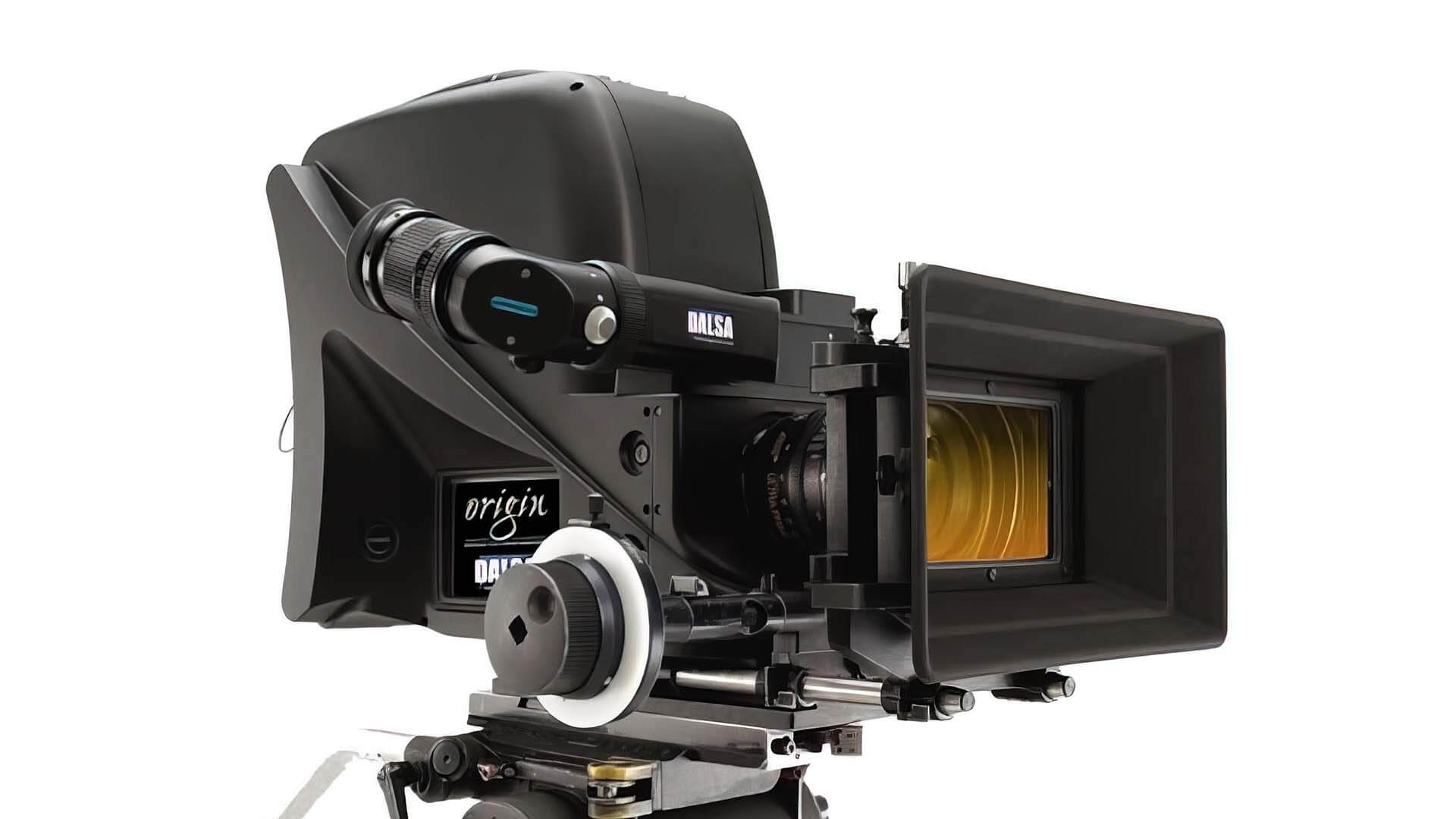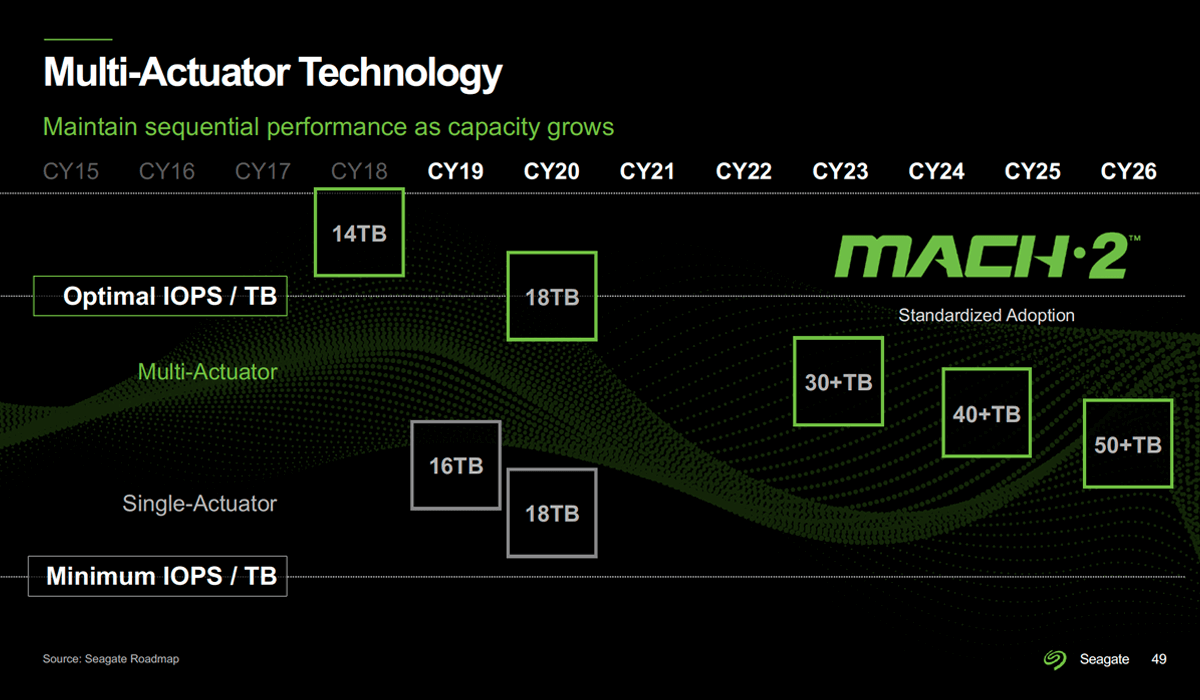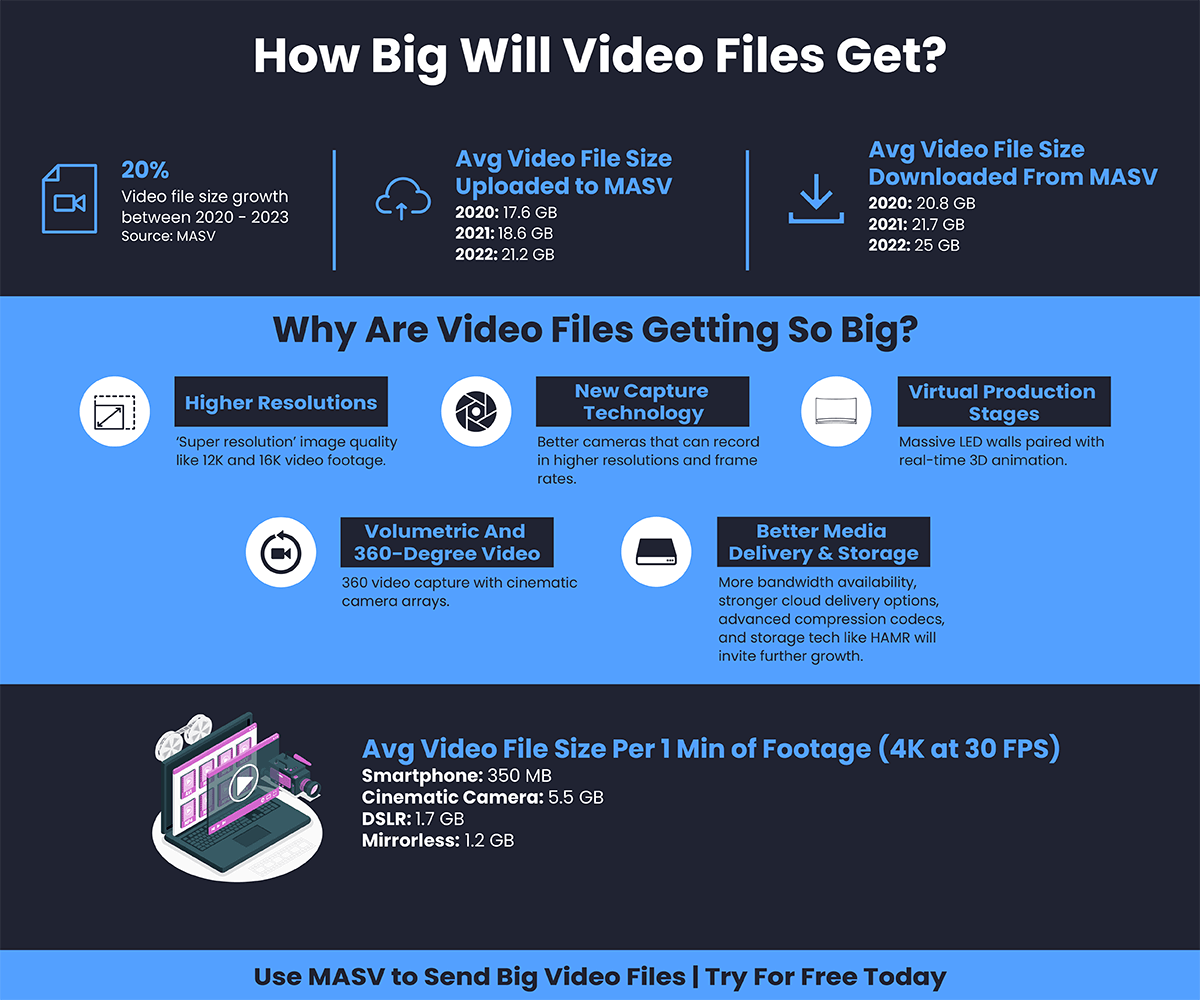Video file sizes have exploded in size over the past decade, and that growth has shown little signs of slowing. If anything, things like new capture technology and better camera resolutions (4K, 8K, 12K, etc.) are set to accelerate file size growth to new heights.
But just how large are large files getting? How much have they grown over the past few years? And how much bigger could they get?
Let’s explore.
Table of Contents
- Just How Big Have Large Video Files Become?
- Why Are Large Video Files Getting So Big?
- Higher Resolutions — ‘super resolution’ image quality like 12K and 16K video footage.
- New Capture Technology — better cameras that can record in higher resolutions and frame rates.
- Virtual and Live Event Production Screens — massive LED walls paired with real-time 3D animation.
- Volumetric And 360-Degree Video — 360 video capture with cinematic camera arrays.
- Better Media Delivery & Storage — broadband improvements, smarter codecs, and advanced storage tech.
- The Future of Video File Sizes
Send Large Video Files With Confidence
Sign up for MASV and start sending and receiving large files quickly and reliably.
Just How Big Have Large Video Files Become?
Because MASV helps video professionals send large video files anywhere on the planet, we’ve got a front-row seat to the steady expansion in video file sizes — and it’s noticeable.
As the table below shows, the average size of both uploads and download packages transferred through MASV’s large file transfer and cloud storage service have increased noticeably each year since 2020.
In concrete terms, the average MASV file package size has increased 20 percent over the past three years, with the largest year-over-year increase occurring in 2022:
| Year | Avg. upload | Avg. download |
| 2020 | 17.6 GB | 20.8 GB |
| 2021 | 18.6 GB | 21.7 GB |
| 2022 | 21.2 GB | 25 GB |
| Overall increase (2020-23) | 20.5 % | 20.2% |
Most MASV users are video and post-production professionals who often send large video files such as RAW and uncompressed large video file types.
But the onward march of higher resolutions and better image quality means the file size of the average video on the internet has increased markedly, as well.
Here’s a sampling of web videos of different resolutions and bitrates and their respective file sizes:
| Resolution | Bitrate | Avg. file size (per min) |
| 480p | 500 Kbps | 2 MB |
| 1080p | 1 Mbps | 5 MB |
| 2K | 5 Mbps | 20 MB |
| 4K | 20 Mbps | 84 MB |
IBM noted a few years ago that average enterprise video file sizes rose nearly 30 percent between 2015 and 2016, even as the average video length fell by eight minutes in the same timeframe.
So what’s causing this rise in video file size?
Transfer Files With No Limitations
Big files? No worries. MASV has no limits on uploads and handles files up to 15 TB.
Why Are Large Video Files Getting So Big?
Many factors affect large video file size including:
- Resolution
- Bitrate
- Frame rate
- Compression ratio
- Color depth
- Video length
Picture improvement technologies such as high dynamic range (HDR) and wide color gamut (WCG) can increase the size of already-large files.
New applications for video, such as virtual production screens and the metaverse, have only added to this upward pressure on large video files.
Here are a few of the most impactful factors fuelling the upswing in large files.
1. Higher Resolutions

Photo by Wan San Yip on Unsplash
We’ll admit that our initial query of “How big will large video files get?” is a bit open-ended, because — spoiler alert — no one really knows the answer.
That’s partly because we’ve now entered what some call the “super resolution” era: A period of video resolution acceleration with virtually no limits.
While 1080p and 4K resolutions were cutting-edge just a few years ago, plenty of cinematic and other video cameras can now handle 6K and 8K jobs with relative ease — along with even higher resolutions such as 12K and 16K.
The limitations of most filmmakers when it comes to such super-high resolutions lie mostly with end-user displays and network speeds. Most of which can’t accommodate anything close to the highest resolutions upon playback. That and equipment cost constraints, of course.
But while finding places to show 12K or 8K video are few and far between, some filmmakers prefer shooting with extremely high resolutions anyway.
That’s because video professionals can shoot in 8K or 12K technology even for a sharper lower-resolution output; a process known as oversampling.
For example, A 12K sensor provides a crisper 8K image than a native 8K sensor; a 4K camera provides a better 2K image, and so on. It’s all thanks to the demosaicing process.
“The highest resolution sensor is best for me because I can make a more measured choice in terms of what I am trying to give the audience visually,” explains Mindhunter cinematographer Erik Messerschmidt in an interview with IBC365. “It has always led to a better image, in my opinion, when I’ve shot on a higher resolution sensor.”
No limits on resolution, however, means there are very few limits on just how big those large video files could ultimately get.
2. New Capture Technology
All these insanely high resolution videos wouldn’t be possible, of course, without insanely high-res technology at the source.
The catalyst for everything mentioned above stems from ever-improving capture technology with better resolution sensors, which ultimately results in very large files.
Most streaming services now offer a 4K delivery standard, with resolutions of 8K and 12K now firmly planted at the high-end of the capture technology spectrum:
- The first-ever 4K cinema camera, the Dalsa Origin, was released in the early 2000s.
- The first 8K camera, the Astrodesign AH-4800, came out in 2013.
- The launch of Blackmagic’s URSA Mini Pro 12K last year allows users to shoot video at 4K, 6K, 8K or 12K (12288 x 6480).

Some filmmakers have even experimented with 16K resolutions using custom multi-camera rigs.
Camera makers are pushing other boundaries, as well, that drive up the size of already large video files.
Frame rate is one such example. Industry standard (ie. “normal-looking”) cinematic frame rates sit at 24 frames-per-second (fps). Broadcast content usually hangs at 30fps. But many cameras now offer frame rates in the hundreds, with slow-motion scenes, in particular, sometimes filmed at frame rates of 200fps or higher. The Phantom Flex4K offers up to 1,000fps at 4096 x 2304 resolution.
One experimental camera now shoots at a mind-numbing 70 trillion fps, although a one-second clip at that heady frame rate would take 92,000 years to play back. You might want to get comfortable.
💡 Check out our analysis of 4K video file sizes, where we calculate how much space a minute of footage would take up on today’s most popular consumer and pro cameras.
For context, a one-hour video shot with the ARRI Alexa Mini LF, using ARRIRAW, at 30fps would sit at around 1.3 terabytes.
Large File Transfer of Raw 4K Footage
Don’t compromise on quality. Send large video files with MASV.
3. Virtual and Live Event Production Screens
You may remember people freaking out when Samsung announced The Wall at CES 2018. The consumer product featured a 146-inch display capable of hitting resolutions of 8K — mind-blowing for the rather quaint standards of the late 2010’s.
Fast-forward a couple years, however, and The Wall is now marketed as a full-on virtual production studio capable of reaching resolutions of 16K on a 1,000-inch screen.
Such eye-popping numbers aren’t even that surprising, however, when you consider the fast growth of virtual production stages regularly featuring such massive LED screens.
As a rule, these large video screens require large files.
The advent of powerful game engines such as Epic Games’ Unreal Engine and proliferation of productions with heavier VFX requirements prompted Deloitte to recently dub virtual production “the future of content creation”.
While the Mandalorian was one of the first major releases to use virtual production back in 2019, many big-name releases (such as Dune, The Batman, The Suicide Squad, Black Adam, and Loki) since have utilized the virtual production workflow.
MELs Studios in Montreal, one of the world’s largest and most popular virtual production facilities, uses a concave wall configuration 65 feet in diameter and 20 feet high. This technology is paired with a 100 GB fiber-optic internet connection to enable the studio to quickly handle large files of several hundred GBs or even TBs in size.
Experiential event companies use similarly heavy files to display 3D visual content on massive LED screens for immersive live events, such as Stimulated Inc.’s virtual stage for the Foo Fighters’ Sonic Highways tour.

4. Volumetric And 360-Degree Video
While the excitement of the metaverse may feel somewhat dampened compared to a year or so ago, big companies are still pouring dollars into it and the technology is real. In fact, the volumetric video market is estimated to reach $21 billion by 2030.
Volumetric video, which uses a camera array to shoot a person or other object in 360 degrees has quickly become an essential tool for the emerging metaverse. It captures movements, facial expressions, and everything else in various angles. Similar to photogrammetry but in video form.
360-degree video is a similar concept used for shooting an environment with cameras facing out. You can even shoot 360 video and perform a volumetric capture inside the 360 video for a truly immersive video experience.
Metastage, a video production company that specializes in volumetric video for the metaverse, regularly shoots with an array of 106 cameras.
“More cameras equals better quality when it comes to capture,” explained Metastage CEO Christina Heller when we spoke with her in late 2021.
The only catch? More cameras also equals larger files. Metastage shoots at 30fps at 12 megapixels (roughly equivalent to 4K), and through its camera array captures a whopping 30 GB of raw data per second.
The largest video files the company has ever stored on Metastage’s on-premises Azure storage? Only around 60 to 70 terabytes.
As technology advances and the metaverse becomes more mature, those file sizes will likely only increase.
Easily Transfer Virtual Production Files
Secure, reliable, and fast transfer of massive 8K or 12K video files with MASV.
5. Storage, Broadband, and Other Technology Improvements
While the developments we’ve mentioned above have helped blow up the size of video files, you still need to store and work with all that data. And ongoing improvements in storage, broadband, and compression have made that possible.
Traditional hard disk drives (HDDs), although slow, are affordable and can now hold up to 20 TB of data. Solid-state drives (SSDs) are faster but more expensive: A 100 TB SSD from Nimbus costs around $40k. SSDs of around 8 TBs or so are considerably cheaper — typically around $1,000, give or take.
Next-generation heat-assisted magnetic recording (HAMR) HDDs are also in development: Seagate says it hopes to ship 30+ TB HAMR drives by 2023 and 50 TB HAMR drives by 2026. HAMR technology can potentially increase HDD data densities by a factor of 100, allowing for higher data density per HDD.

Source: Seagate Roadmap
Steady improvements in residential and commercial broadband have also made the handling of mega-files more realistic. Web service Ookla says fixed broadband download speeds in the U.S. have increased by a 27 percent compound annual growth rate over the past five years. And the Fiber Broadband Association says a typical U.S. family of four will require broadband speeds of at least 2 Gbps by 2030.
At the same time, next-generation video codecs — along with less cumbersome RAW camera formats such as ProResRAW and Blackmagic RAW — will also help alleviate some of the pressure, paving the way for even larger files in the future.
Indeed, dealing with large file sizes is a lot like the cat-and-mouse game of alleviating network congestion. While users and providers can and often do upgrade their network capacity to accommodate increased demands on bandwidth, those demands just keep increasing. The same goes for large file sizes and the technologies that accommodate them.
The Future of Video File Sizes
So, what is the ultimate maximum file size of large files? While no one knows for sure, it’s safe to say the potential for video file growth is virtually limitless. As long as network and playback technologies can support the amount of data that is captured, the sky is the limit.
To recap, video file sizes are growing at a steady pace year-over-year. By our accounts, video file size has increased by 20% in the past three years. IBM reported a 30% increase in the middle of the 2010s. It’s safe to assume the same or even larger leaps on the road to 2030 due to:
- Higher resolution qualities like 12K and 16K graphics.
- Better resolution sensors in cameras that capture more data.
- The mainstream takeover of virtual production stages.
- Filming actors and sets in full 360 view in volumetric stages.
- Advancements in storage, broadband, and compression technology.
The good news is that today’s equally limitless cloud storage services and video file transfer options makes dealing with large video files in video production and post-production a lot less onerous than it was even just a couple years ago.
Send Large Video Files With MASV
MASV large video file transfer can easily send large video files by handling file packages of unlimited size and file uploads of up to 15 TB, while not sacrificing an inch on speed, security, or reliability.
It’s used by some of the largest media companies in the world — including Disney, BBC, Spotify, and PBS — to send large video files from set to studio to distribution (and anywhere else they need to go).
Users can set up MASV Portals, which allow anyone — even those without a login — to use a drag-and-drop interface to send large video files via your MASV account. Just email your Portal link to clients, partners, and other collaborators and they can upload large files to your MASV account.
And MASV’s secure cloud storage service will automatically store your large video file for 5-7 days free, with the option to continue storing files with MASV Unlimited Storage.
Sign-up for MASV and get started for free today.
Get The Best Large File Transfer
Sign up today and use with MASV’s fast, reliably large file transfer.
